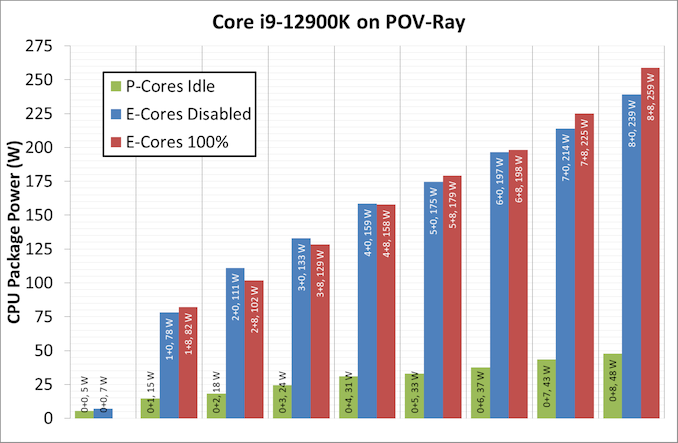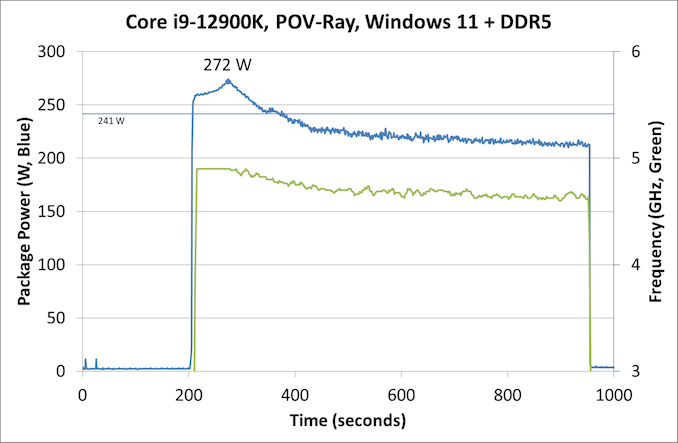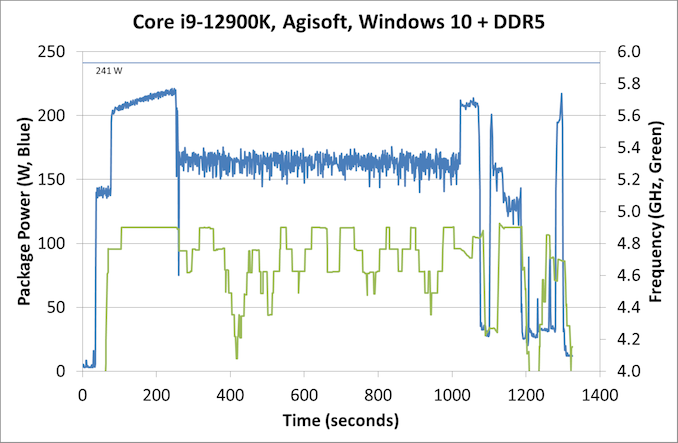The Intel 12th Gen Core i9-12900K Review: Hybrid Performance Brings Hybrid Complexity
by Dr. Ian Cutress & Andrei Frumusanu on November 4, 2021 9:00 AM ESTPower: P-Core vs E-Core, Win10 vs Win11
For Alder Lake, Intel brings two new things into the mix when we start talking about power.
First is what we’ve already talked about, the new P-core and E-core, each with different levels of performance per watt and targeted at different sorts of workloads. While the P-cores are expected to mimic previous generations of Intel processors, the E-cores should offer an interesting look into how low power operation might work on these systems and in future mobile systems.
The second element is how Intel is describing power. Rather than simply quote a ‘TDP’, or Thermal Design Power, Intel has decided (with much rejoicing) to start putting two numbers next to each processor, one for the base processor power and one for maximum turbo processor power, which we’ll call Base and Turbo. The idea is that the Base power mimics the TDP value we had before – it’s the power at which the all-core base frequency is guaranteed to. The Turbo power indicates the highest power level that should be observed in normal power virus (usually defined as something causing 90-95% of the CPU to continually switch) situation. There is usually a weighted time factor that limits how long a processor can remain in its Turbo state for slowly reeling back, but for the K processors Intel has made that time factor effectively infinite – with the right cooling, these processors should be able to use their Turbo power all day, all week, and all year.
So with that in mind, let’s start simply looking at the individual P-cores and E-cores.
Listed in red, in this test, all 8P+8E cores fully loaded (on DDR5), we get a CPU package power of 259 W. The progression from idle to load is steady, although there is a big jump from idle to single core. When one core is loaded, we go from 7 W to 78 W, which is a big 71 W jump. Because this is package power (the output for core power had some issues), this does include firing up the ring, the L3 cache, and the DRAM controller, but even if that makes 20% of the difference, we’re still looking at ~55-60 W enabled for a single core. By comparison, for our single thread SPEC power testing on Linux, we see a more modest 25-30W per core, which we put down to POV-Ray’s instruction density.
By contrast, in green, the E-cores only jump from 5 W to 15 W when a single core is active, and that is the same number as we see on SPEC power testing. Using all the E-cores, at 3.9 GHz, brings the package power up to 48 W total.
It is worth noting that there are differences between the blue bars (P-cores only) and the red bars (all cores, with E-cores loaded all the time), and that sometimes the blue bar consumes more power than the red bar. Our blue bar tests were done with E-cores disabled in the BIOS, which means that there might be more leeway in balancing a workload across a smaller number of cores, allowing for higher power. However as everything ramps up, the advantage swings the other way it seems. It’s a bit odd to see this behavior.
Moving on to individual testing, and here’s a look at a power trace of POV-Ray in Windows 11:
Here we’re seeing a higher spike in power, up to 272 W now, with the system at 4.9 GHz all-core. Interestingly enough, we see a decrease of power through the 241 W Turbo Power limit, and it settles around 225 W, with the reported frequency actually dropping to between 4.7-4.8 GHz instead. Technically this all-core is meant to take into account some of the E-cores, so this might be a case of the workload distributing itself and finding the best performance/power point when it comes to instruction mix, cache mix, and IO requirements. However, it takes a good 3-5 minutes to get there, if that’s the case.
Intrigued by this, I looked at how some of our other tests did between different operating systems. Enter Agisoft:
Between Windows 10 and Windows 11, the traces look near identical. The actual run time was 5 seconds faster on Windows 11 out of 20 minutes, so 0.4% faster, which we would consider run-to-run variation. The peaks and spikes look barely higher in Windows 11, and the frequency trace in Windows 11 looks a little more consistent, but overall they’re practically the same.
For our usual power graphs, we get something like this, and we’ll also add in the AVX-512 numbers from that page:

Compared to Intel’s previous 11th Generation Processor, the Alder Lake Core i9 uses more power during AVX2, but is actually lower in AVX-512. The difficulty of presenting this graph in the future is based on those E-cores; they're more efficient, and as you’ll see in the results later. Even on AVX-512, Alder Lake pulls out a performance lead using 50 W fewer than 11th Gen.
When we compare it to AMD however, with that 142 W PPT limit that AMD has, Intel is often trailing at a 20-70 W deficit when we’re looking at full load efficiency. That being said, Intel is likely going to argue that in mixed workloads, such as two software programs running where something is on the E-cores, it wants to be the more efficient design.














474 Comments
View All Comments
GeoffreyA - Saturday, November 6, 2021 - link
Looking at PC World's review just now, I saw that the 12900K uses less power than the 5950X when the load is lighter but more as it scales to maximum.Zoolook - Saturday, November 6, 2021 - link
To be expected, the fabric on 5950X is a big consumer and it's lit up all the time when only a few cores have work, which makes it performance/power ratio worse when under low load.Oxford Guy - Saturday, November 6, 2021 - link
How exciting that one can pay a lot for a powerful CPU in order to celebrate how it performs doing the tasks a far cheaper CPU would be more suitable for.This is really droll, this new marketing angle for Alder Lake.
GeoffreyA - Sunday, November 7, 2021 - link
Conspicuous consumption?Wrs - Saturday, November 6, 2021 - link
They don't have to redesign Golden Cove. On lightly threaded stuff the 6-wide core is clearly ahead. That's a big plus for many consumers over Zen 3. The smaller competing core is expectedly more efficient and easier to pack for multicore but doesn't have the oomph. That Intel can pack both bigger snappy cores and smaller efficient cores is what should keep Su wide awake.Notice the ease in manufacturing, too. ADL is a simple monolithic slab. Ryzen is using two CCDs and one IOD on interposer. That's one reason Zen3 was in short supply a good 6-8 months after release. It wasn't because TSMC had limited capacity for 88mm2 chips on N7. Intel can spam the market with ADL, the main limit being factory yields of the 208 mm2 chip on Intel 7.
mode_13h - Saturday, November 6, 2021 - link
> On lightly threaded stuff the 6-wide core is clearly ahead.Why do people keep calling it 6-wide? It's not. The decoder is 3 + 3. It can't decode 6 instructions per cycle from the same branch target.
From the article covering the Architecture Day presentation:
"the allocation stage feeding into the reservation stations can only process five instructions per cycle. On the return path, each core can retire eight instructions per cycle."
> That's one reason Zen3 was in short supply a good 6-8 months after release.
> It wasn't because TSMC had limited capacity for 88mm2 chips on N7.
Source?
Shortage of Ryzens was due *in part* to the fact that Epyc and Threadrippers draw from the same chiplet supply as the non-APU desktop chips. And if you tried to buy a Milan Epyc, you'd know those were even harder to find than desktop Ryzen 5000's.
AMD seems to be moving towards a monolithic approach, in Zen 4. Reportedly, all of their desktop CPUs will then be APUs.
mode_13h - Saturday, November 6, 2021 - link
BTW, the arch day quote was meant to show that it's not 6-wide anywhere else, either.GeoffreyA - Sunday, November 7, 2021 - link
6-wide might not be the idiomatic term, but Golden Cove supposedly has 6 decoders, up from 5 on Sunny Cove.Wrs - Sunday, November 7, 2021 - link
Oh we can definitely agree to disagree on how wide to call Golden Cove, but it's objectively bigger than Zen 3 and performs like a bigger core on just about every lightly threaded benchmark.One of many sources suggesting the cause of Ryzen shortage: https://www.tomshardware.com/news/amd-chip-shortag...
The theory that TSMC was simply running that short on Zen3 CCDs never made much sense to me. Covid didn't stop any of TSMC's fabs, almost all of which run fully automated. For over a year they'd been churning out Zen2's on N7 for desktop/laptop and then server, so yields on 85 mm2 of the newer Zen3 on the same N7 should have been fantastic, and they weren't going to server, not till much more recently.
But Covid impacts on the other fabs that make IOD/interposer, and the technical packaging steps, and transporting the various parts in time? Far, far more likely.
mode_13h - Monday, November 8, 2021 - link
> Oh we can definitely agree to disagree on how wide to call Golden CoveSorry, I thought you were talking about Gracemont. The arch day article indeed says it's 6-wide and not much else about the decode stage.
> Covid didn't stop any of TSMC's fabs, almost all of which run fully automated.
It triggered a demand spike, as all the kids and many office workers needed computers for school/work from home. Plus, people needing to do more recreation at home seems to have triggered an increased demand for gaming PCs.
It's well known that TSMC is way backlogged. So, it's not as if AMD could simply order up more wafers to address the demand spikes.
> they weren't going to server, not till much more recently.
Not true. We know Intel and AMD ship CPUs to special customers, even before their public release. By the time Ice Lake SP launched, Intel reported having already shipped a couple hundred thousand of them. Also, AMD needs to build up inventory before they can do a public release. So, the chiplet supply will be getting tapped for server CPUs long before the public launch date.